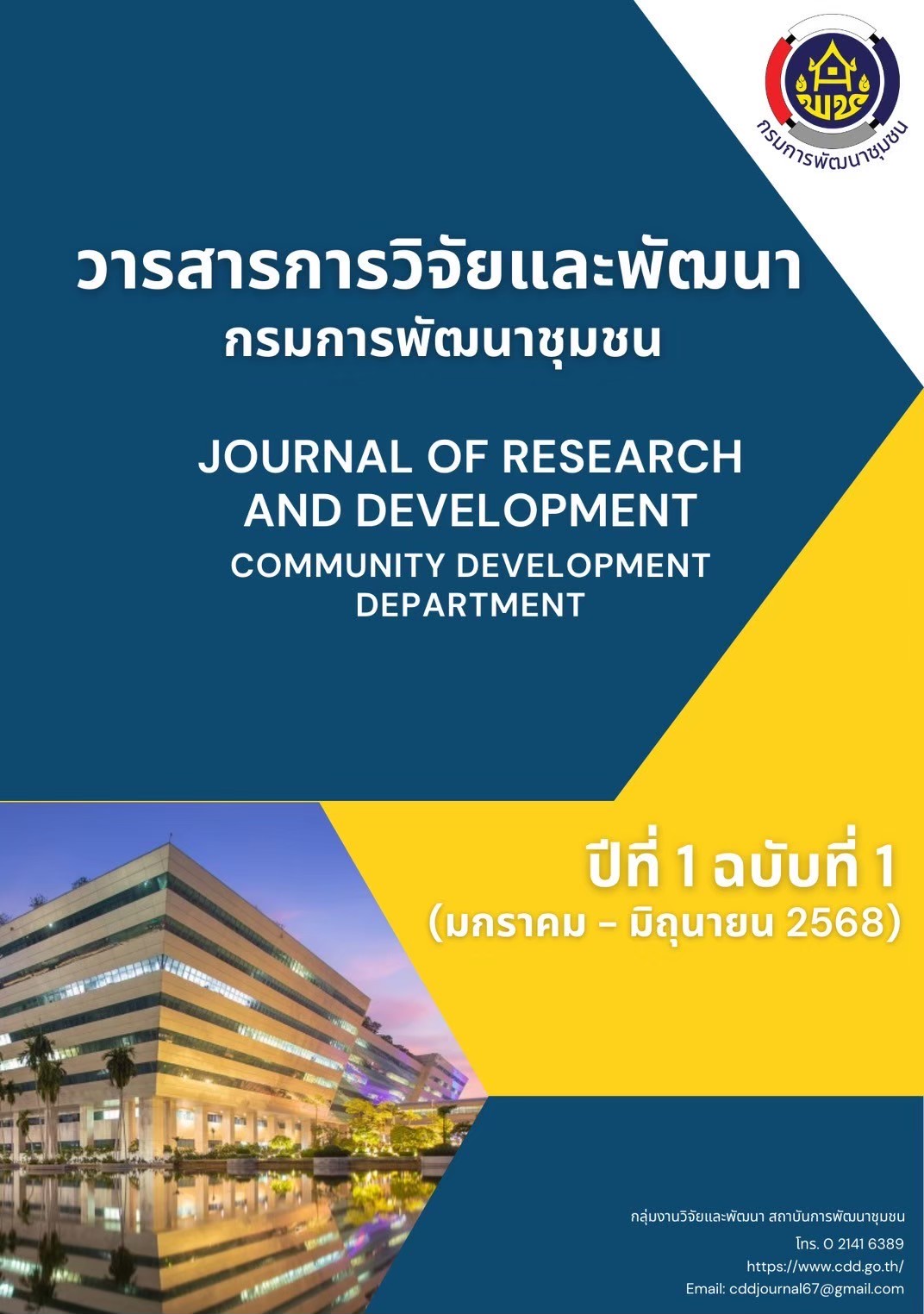Guidelines for Elderly Quality of Life Development Towards Sustainably Poverty Eradication and People of All Ages Development according to the Sufficiency Economy Philosophy
Keywords:
Quality of Life Development, The Elderly, Eradicate Poverty, Philosophy of Sufficiency EconomyAbstract
As the government has focused on preparing for an aging society as Thailand steps into a fully aging society. In other words, there is a population aged 60 years and over which is an important reason that the government has a policy plan and strategy to take care of the elderly population in line with the problems and needs of the elderly, especially in the area of housing. It was found that elderly people tend to spend up to 92.44% of their time in their residences. Regression of body and movement, it is one of the causes of accidents. A slip and fall occurred. Developing a housing model suitable for the elderly using the principles of the "3 B's": be healthy, be happy, and building social bonds to reduce accidents from being inside the house Including improving the quality of life of the elderly in various dimensions. This article therefore presents guidelines for improving the quality of life of the elderly in order to eradicate poverty and develop people of all ages sustainably according to the philosophy of Sufficiency Economy by using the principles in the TPMAP system to develop good quality of life in 5 dimensions. 1) Health: promote, prevent, restore and develop the health system. 2) Living Aspect: adjust the home environment, arrange facilities to be stable and safe. 3) Education: should make use of modern technology and innovation to facilitate the lives of the elderly. 4) In Terms of Income: promote saving for retirement. Including promoting the elderly who are still strong to be healthy, and have the opportunity to work and be self-employed, and also to be able to be self-reliant and 5) Access to Government Services: raise the level of capability towards comprehensive government management according to the joint driving method, plan and define operational procedures, strengthen a positive attitude, promote the creation of value, create income for yourself, promote savings, promote and support the production or training of elderly personnel, and create awareness by going to the area to monitor progress and visiting the target elderly groups continuously to be used to formulate an action plan to help achieve future goals, which response to the government policy to develop the quality of life of the elderly to have potential and continue living a good life.
References
กระทรวงพัฒนาสังคมและความมั่นคงของมนุษย์. พระราชบัญญัติผู้สูงอายุ พ.ศ.2546.
กรุงเทพมหานคร:เจเอสการพิมพ์, 2547.
กรมสุขภาพจิต. ก้าวย่างของประเทศไทย สู่สังคมผู้สูงอายุอย่างสมบูรณ์แบบ. ค้นหาวันที่ 14
พฤษภาคม 2566. เข้าถึงได้จาก https://www.dmh.go.th/news-dmh/view.asp?i
d=30476, 2566.
ไตรรัตน์ จารุทัศน์. รูปแบบที่อยู่อาศัยที่เหมาะสมกับผู้สูงอายุไทยเพื่อส่งเสริมสุขภาพกาย-ใจ
ภายใต้แนวคิดชุมชนที่เป็นมิตรกับผู้สูงอายคณะสถาปัตยกรรมศาสตร์. จุฬาลงกรณ์
มหาวิทยาลัย.
นัสมล บุตรวิเศษและอุปริฏฐา อินทรสาด. ปัจจัยที่ส่งผลต่อคุณภาพชีวิตของผู้สูงอายุ: กรณีศึกษา
อำเภอพระนครศรีอยุธยาจังหวัดพระนครศรีอยุธยา. (รายงานการวิจัย) วิทยาศาสตร์
และเทคโนโลยีมหาวิทยาลัยเทคโนโลยีราชมงคลสุวรรณภูมิ ศูนย์พระนครศรีอยุธยา,
พัชรี หล้าแหล่ง. การศึกษาคุณภาพชีวิตและปัจจัยที่มีอิทธิพลต่อคุณภาพชีวิตของเกษตรกรชาวสวน
ปาล์มน้ำมันในพื้นที่ภาคใต้. รายงานผลการวิจัยเสนอต่อมหาวิทยาลัยแม่โจ้, 2556.
มนตรี ตรีอาภรณ์ไพศาล. อิทธิพลของคุณภาพชีวิตในการทํางานและการรับรู้คุณค่าของงานที่มีต่อ
ความเหนื่อยหน่ายในการทํางานของพนักงานระดับปฏิบัติการสํานักงานคณะกรรมการกิจการกระจายเสียง กิจการโทรทัศน์ และกิจการโทรคมนาคมแห่งชาติ. วารสารวิชาการวิทยาลัยสันตพล, 7(2), 18-25, 2564.
สำนักงานกองทุนสนับสนุนการสร้างเสริมสุขภาพ. การเผชิญหน้า ‘สังคมผู้สูงอายุ’ โจทย์ท้าทายภาระ
ค่าใช้จ่ายที่เพิ่มขึ้น. ค้นหาวันที่ 14 พฤษภาคม 2566. เข้าถึงได้จาก
https://resourcecenter.thaihealth.or.th/article/, 2564.
อุสาสันต์ กอธวัช และคณะ. ปัจจัยที่เกี่ยวข้องกับการรับรู้ความปลอดภัยและสะดวกสบายในการอยู่
อาศัยของผู้สูงอายุที่อยู่ในชุมชน. (รายงานการวิจัย) สาขาการพยาบาลเวชปฏิบัติชุมชน
คณะสาธารณสุขศาสตร์มหาวิทยาลัยมหิดล, 2561.
Maslow A. Motivation and personality. New York: Harper & Row, 1970; 35-58 .
Downloads
Published
Issue
Section
License
Copyright (c) 2025 Journal of Research and Development, Community Development Department

This work is licensed under a Creative Commons Attribution-NonCommercial-NoDerivatives 4.0 International License.






